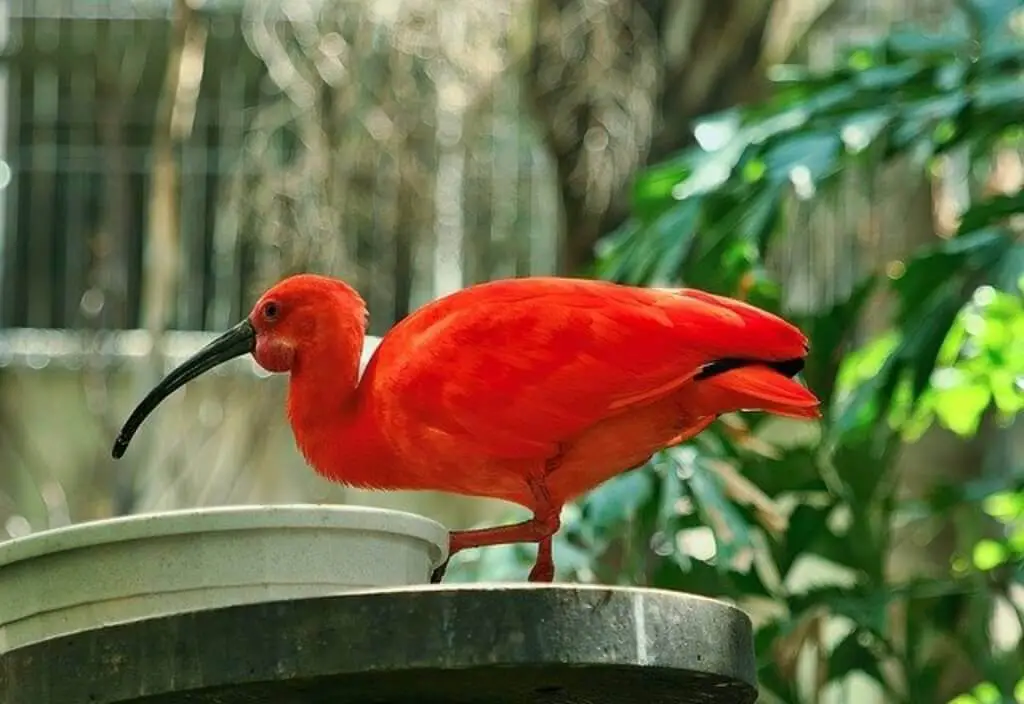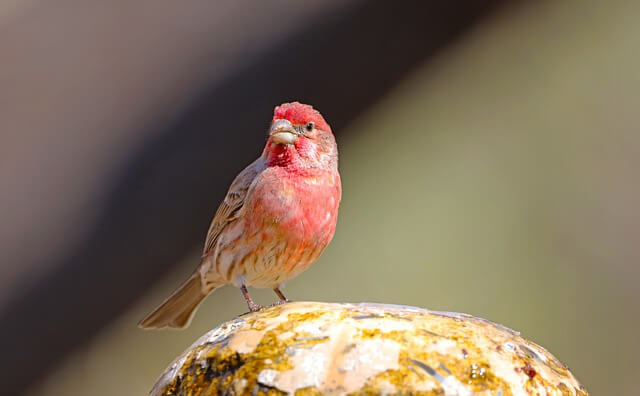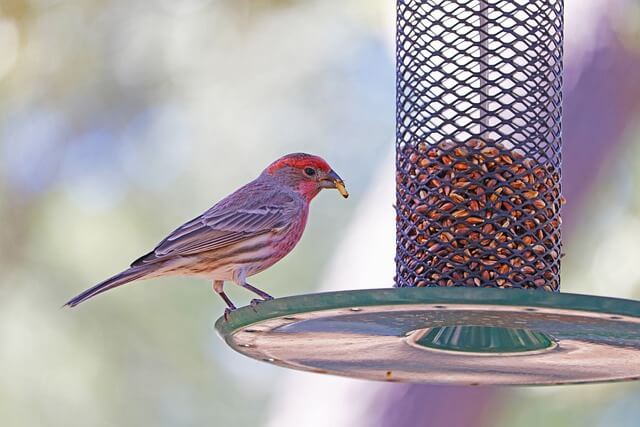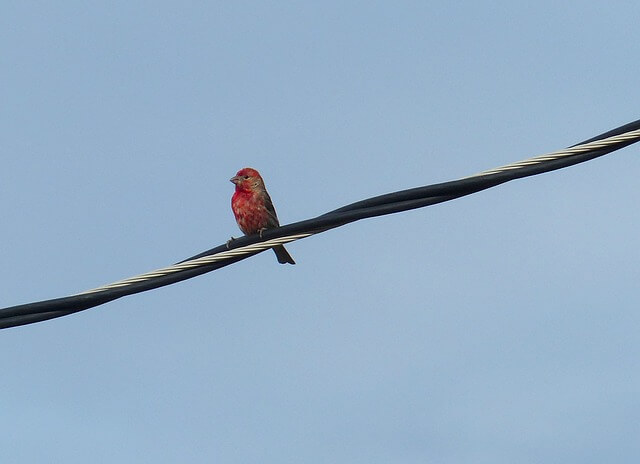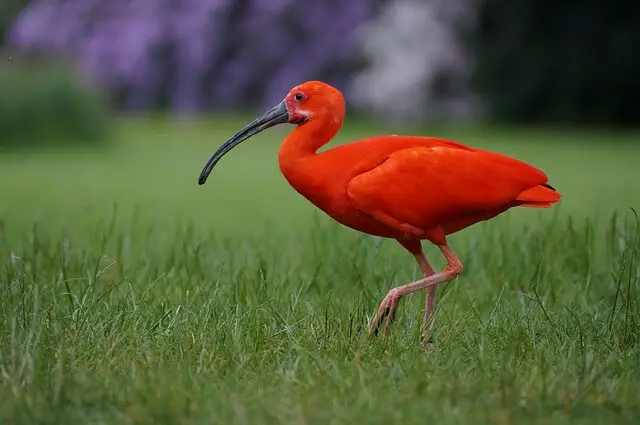Many people think that the only type of red bird is a cardinal. However, there are many types of birds that are red or have feathers in shades of red. This article will go through 16 different types of birds that are red.
Red Birds can be found all over the world and in many climates; from South America to North America, and even Europe, Asia, Africa and Australia!
Table of Contents [show]
Types of Birds That Are Red
Northern Cardinal

The Northern Cardinal is a type of bird that is typically red. They are found in the eastern United States and Canada, as well as parts of Mexico. The Northern Cardinal can be identified by its distinctive crest on its head, bright red plumage, black face mask, and thick pointed bill.
The Northern Cardinal prefers to live in open areas such as forests, parks, gardens, woodlands, meadows and swamps. It has a sharp bill and strong legs for catching insects or eating seeds and fruit. Northern Cardinals eat bugs as well as seeds and fruit.
| Bird | Scientific Name | Length (in) | Weight (oz) | Wingspan (in) |
|---|---|---|---|---|
| Northern Cardinal | Cardinalis cardinalis | 8.3 – 9.3 | 1.5 – 1.8 | 9.8 – 12.2 |
Vermilion Flycatcher
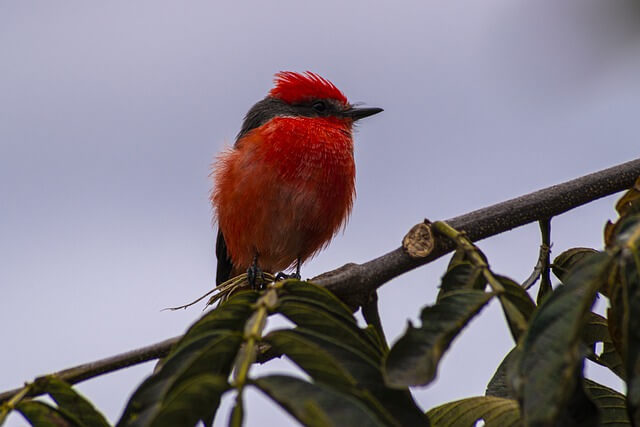
The Vermilion Flycatcher is a small red bird, that is very easy to spot, as it always stands out in the forest. This bird is bright red with black wings and tail feathers. Vermilion Flycatchers live in many places across North America including Alaska, Canada, Mexico and the US (from Oregon to Florida).
It can be seen perched on trees or on branches near water sources like rivers, streams, ponds and lakes. It spends most of its time foraging and catching insects on the ground, but will also catch them in mid-air. Vermilion Flycatchers are monogamous birds which means they only have one mate for life.
| Bird | Scientific Name | Length (in) | Weight (oz) | Wingspan (in) |
|---|---|---|---|---|
| Vermilion Flycatcher | Pyrocephalus rubinus | 5.5 – 6.3 | 0.4 – 0.5 | 9.1 – 10.2 |
Summer Tanager
The Summer Tanager is a bright red bird that is very common in the summer and lives mainly in North America. They spend their summers in the northern United States and Canada, while wintering in Central America and parts of South America. It can be found in woodlands, gardens, parks, and other wooded areas with tall trees or shrubs.
The Summer Tanager is mostly an insect eater with some fruit for extra nutrition. Its diet consists of insects such as ants, beetles, flies and wasps; they will also eat berries from small shrubs and trees if their main food source.
| Bird | Scientific Name | Length (in) | Weight (oz) | Wingspan (in) |
|---|---|---|---|---|
| Summer Tanager | Piranga rubra | 6.3 – 7.1 | 0.6 – 0.8 | 10.6 – 11.8 |
Scarlet Tanager
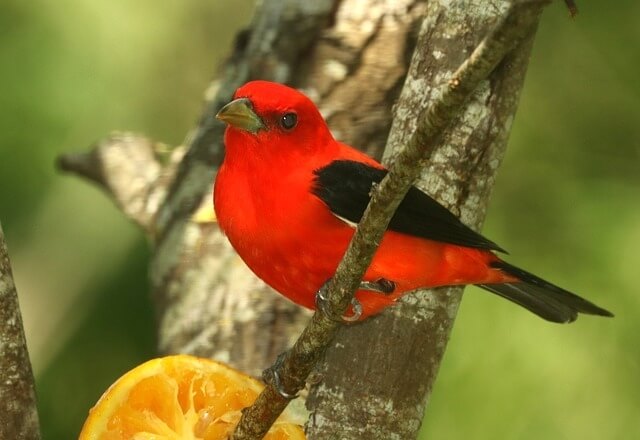
Scarlet Tanager is a medium-sized bird that has red plumage and black wings. This particular species of bird can be found in many regions of North America, with the exception of the Canadian prairies. Scarlet Tanagers inhabit a variety of habitats including woods, thickets, and forest edges.
This type of bird prefers to live near water sources such as rivers or streams. They also frequent meadows where they feed on insects like beetles, flies, and caterpillars as well as fruit such as grapes or berries from plants like dogwood trees.
| Bird | Scientific Name | Length (in) | Weight (oz) | Wingspan (in) |
|---|---|---|---|---|
| Scarlet Tanager | Piranga olivacea | 6.3 – 7.1 | 0.7 – 1.1 | 9.8 – 11.4 |
Masked Crimson Tanager
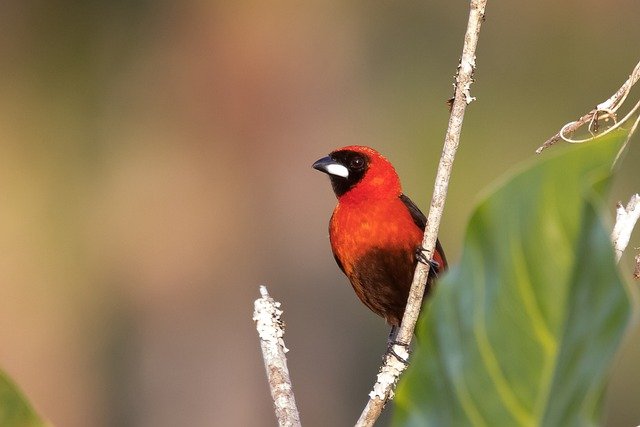
Masked Crimson Tanager is a colorful and beautiful bird that lives in Central America, South America as well as the southwestern United States including Texas. They are usually found in pine forests, orchards, parks and other heavily wooded areas.
Masked Crimson Tanagers have black feathers that cover their face, wings, cloak (lower back), belly and tail which helps them camouflage themselves when they’re perched high up in the trees. In fact most of their body is bright red except for these areas. Masked Crimson Tanagers like to eat berries and insects, so they can be found in areas that have plenty of both for them to feed on.
| Bird | Scientific Name | Length (in) | Weight (oz) | Wingspan (in) |
|---|---|---|---|---|
| Masked Crimson Tanager | Ramphocelus nigrogularis | 7.1 – 7.9 | 1.0 – 1.4 | 10.2 – 11.4 |
Crimson Sunbird
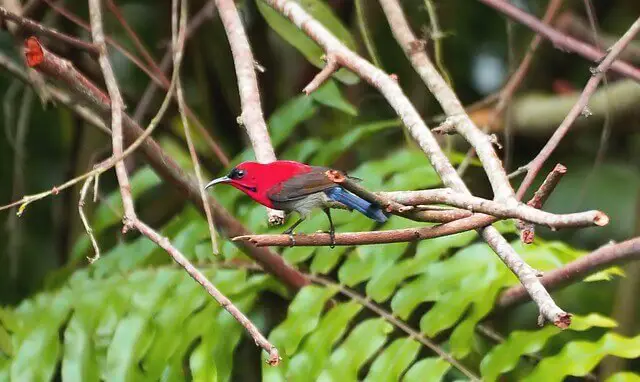
Crimson Sunbirds are medium-sized songbirds that have bright red feathers with an iridescent blue cap and a dark gray belly. The birds have long, curved bills that they used to feed on nectar from flowers or honeydew secreted by aphids in trees.
They’re native to Asia, but they can also be found in India, Thailand, Laos, Vietnam and Indonesia. The male Crimson Sunbird is slightly smaller than the female because it has a shorter tail. Crimson Sunbirds live in dense tropical forests near rivers or lakes where there’s plenty of vegetation for food and shelter.
| Bird | Scientific Name | Length (in) | Weight (oz) | Wingspan (in) |
|---|---|---|---|---|
| Crimson Sunbird | Aethopyga siparaja | 3.9 – 4.3 | 0.2 – 0.3 | 5.9 – 6.3 |
Pine Grosbeak
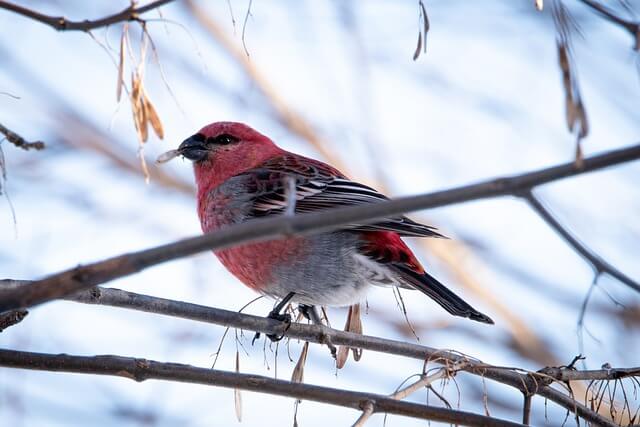
The Pine Grosbeak is a medium-sized songbird that lives in boreal forests and woodlands. Pine Grosbeaks are rosy colored plumage throughout with black wings with white wing bars and a large bill. This bird’s common habitat includes mixed or deciduous forests, forest edges, open areas near water sources such as streams or rivers, parks, farms, shrub lands and suburban gardens across Eastern North America.
The main diet of this bird includes seeds, fruits, insects, buds and nectar from flowers. When they first arrive in the springtime they eat small caterpillars that hide under leaves on trees.
| Bird | Scientific Name | Length (in) | Weight (oz) | Wingspan (in) |
|---|---|---|---|---|
| Pine Grosbeak | Pinicola enucleator | 8.3 – 9.1 | 2.5 – 3.5 | 14.2 – 15.8 |
House Finch
The House Finch is a small, ground-feeding bird, that is native to western North America and can be found from coast to coast in the United States. They are mostly found in urban areas because they eat insects around homes like spiders or ants as well as seeds around yards which attracts them to humans. Males have a bright red color on their head and upper breast with a streaked brown belly, back, and tail.
House Finches feed on seeds, grains, berries and insects that they find on the ground or while hopping along branches of trees. They nest in cavities such as holes in trees or wall crevices. It’s common for them to nest near buildings, especially if they’re located near a bird feeder or bird bath.
| Bird | Scientific Name | Length (in) | Weight (oz) | Wingspan (in) |
|---|---|---|---|---|
| House Finch | Haemorhous mexicanus | 4.9 – 5.9 | 0.6 – 1.1 | 8.3 – 10.2 |
Purple Finch
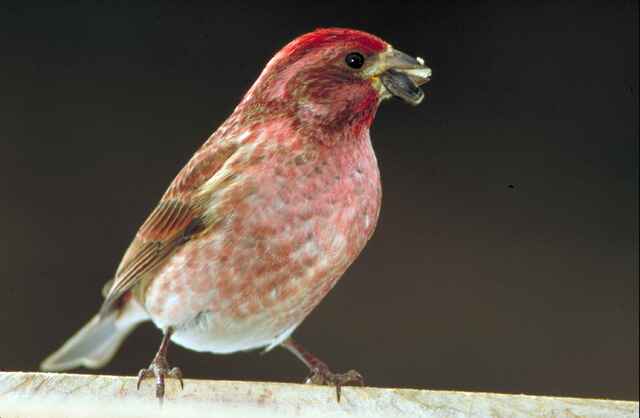
Purple Finch are small songbirds native to North America, they have a red head, breast, back and rump, with a streaked back. These birds eat mostly seeds of grasses and weeds. Purple Finches live in mixed deciduous forests or pine woodlands from the east coast westward across Canada to central Alaska.
They feed on the ground during most of the year but will also fly up into trees when disturbed. Purple finches live in many habitats from meadows to suburban yards and wetlands. They often nest in trees but also use cavities created by woodpeckers in dead tree trunks or human-made birdhouses.
| Bird | Scientific Name | Length (in) | Weight (oz) | Wingspan (in) |
|---|---|---|---|---|
| Purple Finch | Haemorhous purpureus | 4.7 – 6.3 | 0.6 – 1.1 | 9.8 – 11.8 |
Rosefinch
Rose Finch is a Eurasian bird, that is native to Asia and Europe but can be found throughout North America. They have red heads, breast, and rump with a whitish-red bellies. Rose Finch are common in agricultural areas as they feed on insects such as beetles, aphids, wasps, ants and caterpillars among other things.
The bill is small with a short hook at the end; this allows them to pick up insects from the ground easily while they forage. They are monogamous and will stay with their mate for life unless they find another partner of the same species or if one dies. Their nesting period is April to July. They nest on the ground usually in fields, meadows, or open woodland areas near water bodies.
| Bird | Scientific Name | Length (in) | Weight (oz) | Wingspan (in) |
|---|---|---|---|---|
| Rosefinch | Carpodacus spp. | 4.7 – 7.1 | 0.4 – 1.8 | 8.7 – 13.0 |
Red-Billed Firefinch
The Red-Billed Firefinch is a small bird that resides in Africa. It has bright red plumage with brown wings, a pink bill and a yellow ring around its eye. They are native to the countries of Angola, Botswana, Malawi, Mozambique, Namibia, Zambia and Zimbabwe where they inhabit areas of Savannah grassland or dense scrubby vegetation near water sources such as rivers or lakes.
When on the ground these birds feed mainly on seeds. They feed on seeds from grasses and hedges as well as insects such as locusts, beetles, caterpillars and moths. The male does not take care of the young but instead is solely focused on mating.
| Bird | Scientific Name | Length (in) | Weight (oz) | Wingspan (in) |
|---|---|---|---|---|
| Red-Billed Firefinch | Lagonosticta senegala | 3.1 – 4.3 | 0.3 – 0.4 | 5.9 – 7.1 |
Cassin’s Finch
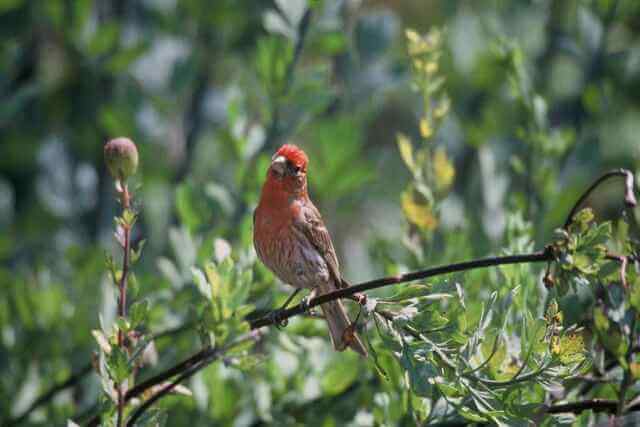
The Cassin’s Finch is a type of small songbird that can be found all over North America but more specifically from southern Canada to central Mexico. They are small songbirds with an average length of 16 cm. They have red heads, breasts, backs and brown wings and tail. Adults males are distinguished by their crimson head feathers while females have brown ones.
This is a seasonal bird because they are only seen during the winter months in their natural habitat. The Cassin’s finch lives on coniferous trees for nesting sites and food sources. They mainly eat seeds from conifers but will also take berries and insects to supplement their diet.
| Bird | Scientific Name | Length (in) | Weight (oz) | Wingspan (in) |
|---|---|---|---|---|
| Cassin’s Finch | Haemorhous cassinii | 5.1 – 6.3 | 0.6 – 0.8 | 8.7 – 10.2 |
Crossbill
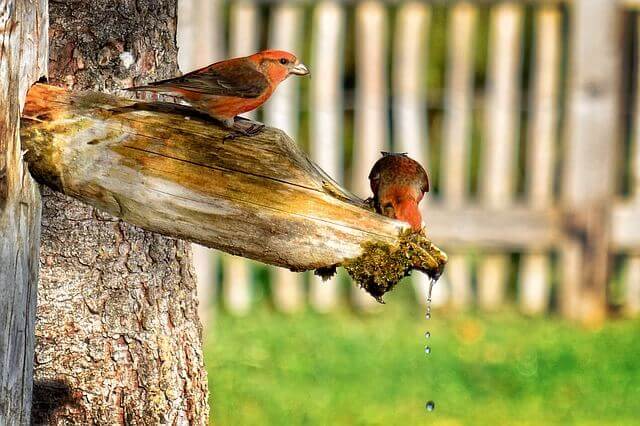
Crossbills are an interesting species of bird. They’re not your average bird and can be found in the northeastern United States, southeastern Canada, northwestern Europe, Russia, China and Japan. Crossbills live in boreal forests in North America and Eurasia during the summer months and migrate south for winter, spending time at sea when it’s too cold to be on land.
They have a unique bill that is very long and crosses over at the tips, which helps them to get seeds out of pine cones. Adult males are red or orange while the females are greenish-yellow. This difference in color makes it easy for birds to tell each other apart during mating season.
| Bird | Scientific Name | Length (in) | Weight (oz) | Wingspan (in) |
|---|---|---|---|---|
| Crossbill | Loxia spp. | 5.5 – 7.9 | 0.8 – 1.6 | 9.8 – 12.2 |
Scarlet Ibis
Scarlet Ibis are some of the most beautiful birds in North America. This bird can be found on both coasts and throughout Central America, but they migrate to Louisiana for the winter. The Scarlet Ibis’ feathers are brilliant red, making it stand out from other birds, with black wingtips.
When they fly, their bright red feathers and black wingtips show up against the blue sky or green forest. The Scarlet Ibis is a migratory bird found exclusively on the coasts of south Florida and lives off of small fish, crabs, shrimp, frogs and insects for food. They use mud to build nests on tree branches during breeding season.
| Bird | Scientific Name | Length (in) | Weight (oz) | Wingspan (in) |
|---|---|---|---|---|
| Scarlet Ibis | Eudocimus ruber | 23.6 – 34.6 | 24.7 – 56.4 | 38.6 – 54.3 |
Crimson Rosella
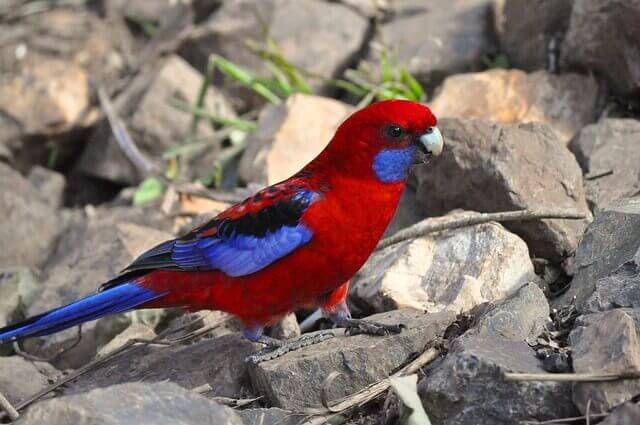
Crimson Rosella is a parrot native to Australia, that are about 15-18 inches long and have a lifespan of up to 30 years. It has bright red feathers with blue cheeks, wings and tail. They are found in the drier regions of eastern and central Australia, including Victoria, New South Wales, Queensland and Western Australia.
It can be found in many habitats including rainforests, scrublands, and woodlands. The Crimson Rosella have sharp beaks which they use for climbing trees as well as feeding on berries, nectar, seeds and buds from trees and shrubs.
| Bird | Scientific Name | Length (in) | Weight (oz) | Wingspan (in) |
|---|---|---|---|---|
| Crimson Rosella | Platycercus elegans | 12.2 – 14.2 | 3.5 – 5.3 | 17.7 – 20.1 |
Red Fody
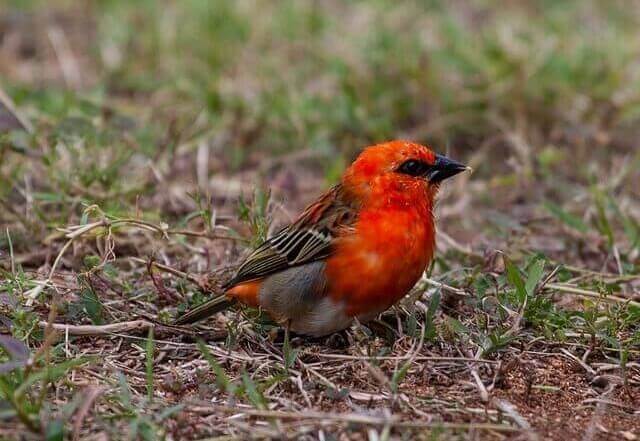
The Red Fody is a small, sparrow-sized passerine bird native to Madagascar. It can be found on the island’s forests and woodlands. The fody gets its name from the bright red plumage on its head and neck. It has a brown back with black wings and tail feathers that are also tipped in white.
Fodies have been observed nesting high up in trees as well as on the ground among dead leaves or under bushes. They eat mostly insects, seeds, fruits and nectar that they find on the ground or plants depending on what’s available to them.
| Bird | Scientific Name | Length (in) | Weight (oz) | Wingspan (in) |
|---|---|---|---|---|
| Red Fody | Foudia madagascariensis | 4.7 – 5.5 | 0.5 – 0.7 | 8.7 – 9.8 |
Conclusion
Red birds are some of the most striking and beautiful birds in the world, with their vibrant colors and unique features. From the Scarlet Ibis to the Crimson Rosella, these 16 types of red birds offer a glimpse into the diversity of bird species.
By learning about their scientific names, length, weight, and wingspan, we can appreciate the beauty and complexity of these fascinating creatures. Whether you’re a bird enthusiast or just appreciate the beauty of nature, exploring these 16 types of red birds is sure to inspire awe and wonder.

